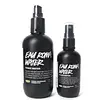What's inside
What's inside
 Key Ingredients
Key Ingredients

No key ingredients
 Benefits
Benefits

 Concerns
Concerns

 Ingredients Side-by-side
Ingredients Side-by-side

Water
Skin ConditioningLavandula Angustifolia Flower Extract
CleansingAnthemis Nobilis Flower Extract
MaskingAlcohol Denat.
AntimicrobialButylene Glycol
HumectantAnthemis Nobilis Flower Oil
MaskingMentha Viridis Leaf Oil
AstringentPelargonium Graveolens Flower Oil
MaskingLavandula Hybrida Oil
EmollientCitrus Aurantium Bergamia Fruit Oil
MaskingStyrax Benzoin Gum
MaskingGeraniol
PerfumingLinalool
PerfumingCitronellol
PerfumingEugenol
PerfumingLimonene
PerfumingHamamelis Virginiana Extract
AntiseborrhoeicOryza Sativa Bran Extract
Skin ConditioningCladosiphon Okamuranus Extract
Skin ConditioningLaminaria Saccharina Extract
Skin ProtectingEugenia Caryophyllus Flower Extract
AstringentHydrolyzed Soy Protein
HumectantHydrolyzed Wheat Protein
Skin ConditioningHydrolyzed Corn Protein
Skin ConditioningCoconut Acid
CleansingJojoba Wax PEG-120 Esters
Caffeine
Skin ConditioningGlycerin
HumectantPolyquaternium-7
Sodium Hyaluronate
HumectantDextrin
AbsorbentYeast Extract
Skin ConditioningDisodium EDTA
Phenoxyethanol
PreservativeAquilaria Agallocha Wood Oil
MaskingWater, Lavandula Angustifolia Flower Extract, Anthemis Nobilis Flower Extract, Alcohol Denat., Butylene Glycol, Anthemis Nobilis Flower Oil, Mentha Viridis Leaf Oil, Pelargonium Graveolens Flower Oil, Lavandula Hybrida Oil, Citrus Aurantium Bergamia Fruit Oil, Styrax Benzoin Gum, Geraniol, Linalool, Citronellol, Eugenol, Limonene, Hamamelis Virginiana Extract, Oryza Sativa Bran Extract, Cladosiphon Okamuranus Extract, Laminaria Saccharina Extract, Eugenia Caryophyllus Flower Extract, Hydrolyzed Soy Protein, Hydrolyzed Wheat Protein, Hydrolyzed Corn Protein, Coconut Acid, Jojoba Wax PEG-120 Esters, Caffeine, Glycerin, Polyquaternium-7, Sodium Hyaluronate, Dextrin, Yeast Extract, Disodium EDTA, Phenoxyethanol, Aquilaria Agallocha Wood Oil
Alternatives
Ingredients Explained
These ingredients are found in both products.
Ingredients higher up in an ingredient list are typically present in a larger amount.
Citronellol is used to add fragrance/parfum to a product. It is often derived from plants such as roses. In fact, it can be found in many essential oils including geranium, lavender, neroli, and more. The scent of Citronellol is often described as "fresh, grassy, and citrus-like".
Since the Citronellol molecule is already unstable, Citronellol becomes irritating on the skin when exposed to air.
Citronellol is a modified terpene. Terpenes are unsaturated hydrocarbons found in plants. They make up the primary part of essential oils.
Citronellol is not able to be absorbed into deeper layers of the skin. It has low permeability,
Citronellol is also a natural insect repellent.
Learn more about CitronellolGeraniol is used to add fragrance/parfum to a product. It is the main component of citronellol. It is a monoterpenoid and an alcohol.
Monoterpenes are naturally found in many parts of different plants.
Geraniol can be found in many essential oils including Rose Oil and Citronella Oil. The scent of Geraniol is often described as "rose-like". Many foods also contain Geraniol for fruit flavoring.
Geraniol can irritate the skin when exposed to air. However, irritation depends on the ability of geraniol to penetrate into the skin. In general, geraniol is not able to penetrate skin easily.
Geraniol is colorless and has low water-solubility. However, it is soluble in common organic solvents.
Like citronellol, it is a natural insect repellent.
2,6-Octadien-1-ol, 3,7-dimethyl-, (2E)-
Learn more about GeraniolLimonene is a fragrance that adds scent and taste to a formulation.
It's found in the peel oil of citrus fruits and other plants such as lavender and eucalyptus. The scent of limonene is generally described as "sweet citrus".
Limonene acts as an antioxidant, meaning it helps neutralize free radicals.
When exposed to air, oxidized limonene may sensitize the skin. Because of this, limonene is often avoided by people with sensitive skin.
The term 'fragrance' is not regulated in many countries. In many cases, it is up to the brand to define this term. For instance, many brands choose to label themselves as "fragrance-free" because they are not using synthetic fragrances. However, their products may still contain ingredients such as essential oils that are considered a fragrance.
Learn more about LimoneneLinalool is a fragrance and helps add scent to products. It's derived from common plants such as cinnamon, mint, citrus, and lavender.
Like Limonene, this ingredient oxidizes when exposed to air. Oxidized linalool can cause allergies and skin sensitivity.
This ingredient has a scent that is floral, spicy tropical, and citrus-like.
Learn more about Linalool